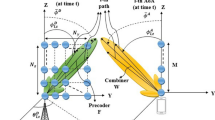Abstract
A nonuniform array group is proposed to solve the inflexibility problem of existing nested arrays. The array structure in the group is not required to be composed of two or more uniform linear sub-arrays on the premise of maintaining the same degree of freedom as that of nested arrays. Compared with nested arrays, a nonuniform array group is easier to arrange in airborne radar or limited physical space. For the nonuniform array group proposed in this study, an array is randomly selected for deployment, and the covariance matrix of the data received by the array is quantised. Accordingly, an algorithm for data de-redundancy and sorting is proposed, and the virtual array receiving data are obtained. Lastly, the target direction of arrival (DOA) is estimated using a sparse reconstruction method without losing array aperture. Simulation results show that the proposed method can achieve accurate DOA estimations at low signal-to-noise ratio and snapshot number.










Similar content being viewed by others
References
Elbir, A. M. (2017). Direction finding in the presence of direction-dependent mutual coupling. IEEE Antennas and Wireless Propagation Letters, 16, 1541–1544.
Wen, F., Wan, Q., Fan, R., et al. (2014). Improved MUSIC algorithm for multiple noncoherent subarrays. IEEE Signal Processing Letters, 21(5), 527–530.
Herzog, A., & Habets, E. A. P. (2019). Eigenbeam-ESPRIT for DOA-vector estimation. IEEE Signal Processing Letters, 26(4), 572–576.
Lin, J. C., Ma, X. C., Yan, S. F., et al. (2016). Time-frequency multi-invariance ESPRIT for DOA estimation. IEEE Antennas and Wireless Propagation Letters, 15, 770–773.
Li, J. F., & Zhang, X. F. (2012). Improved two-dimensional DOA estimation algorithm for two-parallel uniform linear arrays using propagator method. Signal Processing, 92(12), 3032–3038.
Wang, L. M., Yang, L., Wang, G. B., et al. (2015). DOA and polarization estimation based on sparse COLD array. Wireless Personal Communications, 85(4), 2447–2462.
Li, J., & Jiang, D. (2017). Joint elevation and azimuth angles estimation for L-shaped array. IEEE Antennas and Wireless Propagation Letters, 16, 453–456.
Pal, P., & Vaidyanathan, P. P. (2010). Nested array: A novel approach to array processing with enhanced degrees of freedom. IEEE Transactions on Signal Processing, 58(8), 4167–4181.
Pal, P., & Vaidyanathan, P. P. (2012). Nested arrays in two dimensions, part I: Geometrical considerations. IEEE Transactions on Signal Processing, 60(9), 4694–4705.
Liu, C., & Vaidyanathan, P. P. (2016). Super nested arrays: Linear sparse arrays with reduced mutual coupling–part I: Fundamentals. IEEE Transactions on Signal Processing, 64(15), 3997–4012.
Pal, P., & Vaidyanathan, P. P. (2012). Multiple level nested array: An efficient geometry for \(2q\)th order cumulant based array processing. IEEE Transactions on Signal Processing, 60(3), 1253–1269.
Iizuka, Y., & Ichige, K. (2016). Extension of two-level nested array with larger aperture and more degrees of freedom. In 2016 international symposium on antennas and propagation (ISAP) (pp. 442–443). Okinawa.
Yang, M., Sun, L., Yuan, X., et al. (2016). Improved nested array with hole-free DCA and more degrees of freedom. Electronics Letters, 52(25), 2068–2070.
Li, J., Li, Y., & Zhang, X. (2019). Direction of arrival estimation using combined coprime and nested array. Electronics Letters, 55(8), 487–489.
Han, X., Shu, T., He, J., et al. (2018). Polarization-angle-frequency estimation with linear nested vector sensors. IEEE Access, 6, 36916–36926.
Pillai, S. U., & Kwon, B. H. (1989). Forward/backward spatial smoothing techniques for coherent signal identification. IEEE Transactions on Acoustics, Speech, and Signal Processing, 37(1), 8–15.
Ma, W., Hsieh, T., & Chi, C. (2010). DOA estimation of quasi-stationary signals with less sensors than sources and unknown spatial noise covariance: A Khatri–Rao subspace approach. IEEE Transactions on Signal Processing, 58(4), 2168–2180.
Pourhomayoun, M., Fowler, M. L., & Wu, N. E. (2012). Spatial sparsity based emitter localization. In 2012 46th annual conference on information sciences and systems (CISS) (pp. 1–4). Princeton, NJ
Donoho, D. L. (2006). Compressed sensing. IEEE Transactions on Information Theory, 52(4), 1289–1306.
Candès, E. J. (2006). Compressive sampling. Proceedings of the International Congress of Mathematicians, 3, 1433–1452.
Sidiropoulos, N. D., & Kyrillids, A. (2012). Multi-way compressed sensing for sparse low-rank tensors. IEEE Signal Processing Letters, 19(11), 757–760.
Acknowledgements
This work was supported by the National Natural Science Foundation of China under Contract (61772398, 61972239), the Key Research and Development Program Projects of Shaanxi Province (2019SF-257), the Special Scientific Research Project of Shaanxi Provincial Education Department (18JK0144), the Opening Foundation of Shaanxi University of Technology Shaanxi Key Laboratory of industrial Automation (SLGPT2019KF01-15), and the Science and Technology Program of Hantai District (2019KX-21). The authors would like to thank the anonymous reviewers and the associated editor for their valuable comments and suggestions that improved the clarity of this manuscript.
Author information
Authors and Affiliations
Corresponding author
Additional information
Publisher's Note
Springer Nature remains neutral with regard to jurisdictional claims in published maps and institutional affiliations.
Rights and permissions
About this article
Cite this article
Wang, L., Hui, Z., Wang, S. et al. Underdetermined DOA Estimation Algorithm Based on an Improved Nested Array. Wireless Pers Commun 112, 2423–2437 (2020). https://doi.org/10.1007/s11277-020-07157-w
Published:
Issue Date:
DOI: https://doi.org/10.1007/s11277-020-07157-w




